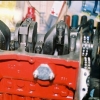Hi mates,
Thanks for all your messages, I've learned a lot.
Two things first :
- I don't have no particular electronics design skills. I can handle the simplest kinds of work as I do really enjoy it but nothing more complicated.
- I already have a vacuum meter and I really like it ; I also already have a clock.
KernowCooper : I'll remember that rule of thumb of a 30% leeway.
My amp-meter is a brand new Smiths one, it doesn't really feel great as it is quite small and essentially made of cheap plastic... I wouldn't trust it now that I know how high is the power going through the meter.
Tiger : well I don't really have electronics design capabilities and I won't try to fit some kind of computerized things in my Mini. Not because I wouldn't be interested in doing it but because it's way too complicated for me as I do not have any technical knowledge... I can plug a wire between two objects but I can't do a lot more.
Tell me more about a "Hall effect current sensor" as I couldn't find a lot of things on Google. I quite understand the way it's supposed to work but I haven't find any to buy so it must be more complicated that what I figure.
Mike Spider : I've read a few things about shunted meters and you're right, they actually exist for the automotive market but they're designed to fit modern cars. My others gauges being Smiths ones with the classic chrome bezel, I don't want to fit a black plastic gauge next to them...
And trying to extract the mechanism of a modern shunted meter to install it in a vintage looking gauge is way ahead of my skills.
Thanks again for all the informations.
I know definitely think that the fitting of a working amp meter ain't that interesting given how dangerous it could be and how unnecessary it is... (Even though I really like unnecessary things...just not when they could cause a major failure).
Edited by Roro92, 17 July 2016 - 10:49 PM.





















